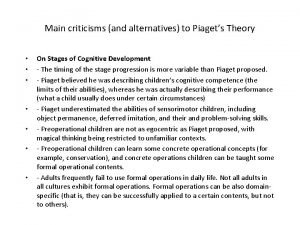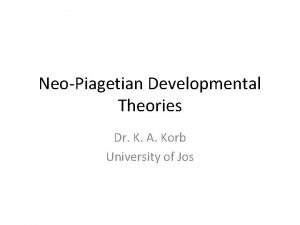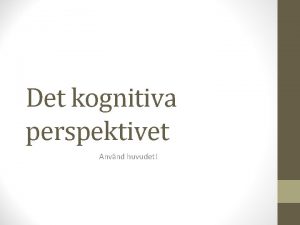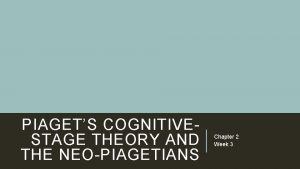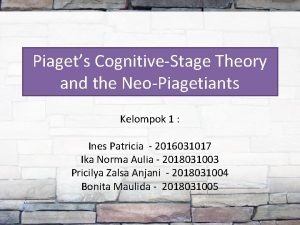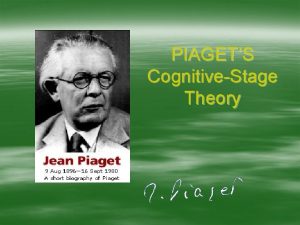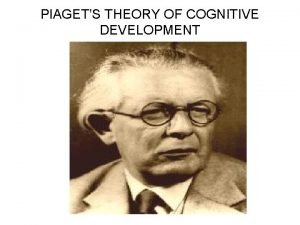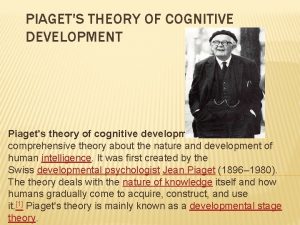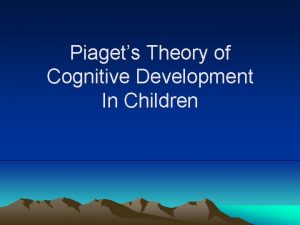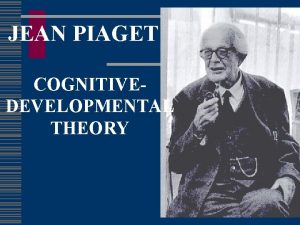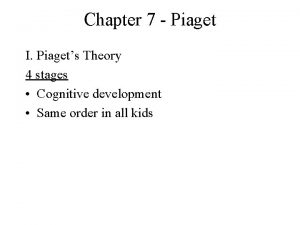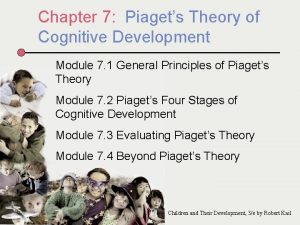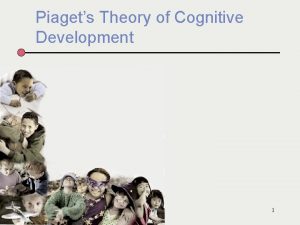PIAGETS COGNITIVESTAGE THEORY AND THE NEOPIAGETIANS Chapter 2

















- Slides: 17

PIAGET’S COGNITIVESTAGE THEORY AND THE NEO-PIAGETIANS Chapter 2 Week 3

PIAGET The most important figure in developmental psychology Children actively construct knowledge Thinking progress through various stages from birth to maturity

BIOGRAPHICAL SKETCHES 1896 -1980, Nueuchâtel, Switzerland Family: Turbulent Interests: Wide-range Education: natural sciences (malacology) + psychology and philosophy Research focus: children’s thought process psychiatric interviewing technique

GENERAL ORIENTATION TO THEORY (1) Genetic Epistemology o. The study of developmental changes in the process of knowing and in the organization of knowledge o. Experimental epistemologist o. Knowledge is a process people construct knowledge cognitive system develops Biological Approach o. Cognitive growth adaptation to the environmen

GENERAL ORIENTATION TO THEORY (2) Structuralism o. Thoughts is organized – the parts relate to the whole o. Scheme: an organized partern of behavior reflecting a particular way of interacting with the environment repeatable and generalizable Stage Approach o. Stage: a period of time during which the child’s thinking and behavior in a variety of situations tend to reflect a particular type of underlying mental structure o. Structured wholes that emerge from and transform a previous stage, follow an invariant and universal sequence and proceed from an unstable period of transition to a final stable period

METHODOLOGY o. Clinical method – a chainlike verbal interaction o. Manipulation of objects o. Observation

DESCRIPTION OF STAGES (1) Sensorimotor Period (0 -2 Years) (1) o. Stage 1: Modification of Reflexes (0 -1 Month) The baby strengthens, generalizes and differentiate behaviors Reflexes Schemes o. Stage 2: Primary Circular Reaction (1 -4 Months) Circular reaction: a behavior is repeated over and over circular Primary: centered on/around the infant’s body o. Stage 3: Secondary Circular Reaction (4 -8 Months) Secondary: oriented to the external world Motor recognition

DESCRIPTION OF STAGE (2) Sensorimotor Period (0 -2 Years) (2) o. Stage 4: Coordination of Secondary Schemes (8 -12 Months) Combining schemes, including using objects, to achieve goals in new situation o. Stage 5: Tertiary Circular Reactions (12 -18 Months) Active experimentation o. Stage 6: Invention of New Means through Mental Combination (18 -24 Months) The use of symbol to represent objects and events

DESCRIPTION OF STAGE (3) Sensorimotor Period (0 -2 Years) (3) Overview o. A child: Active learning o. Cognitive structure: More organized o. Behavior: More intentional o. Self: More differentiated Object Permanence o. The object continues to exist even when one cannot see, hear or feel it

DESCRIPTION OF STAGE (4) Preoperational Period (2 -7 Years) Mental representations o. Symbol and sign o. Not yet reversible Characteristics of the period o. Egocentrism o. Rigidity of thought o. Semilogical reasoning o. Limited social cognition

DESCRIPTION OF STAGE (5) Concrete Operational Period (7 -11 Years) o. Operation: an internalized mental action that is part of an organized structure o. Class o. Relation o. Temporal-Spatial representations

DESCRIPTION OF STAGE (6) Formal Operational Period (11 -15 Years) Mental operations are applied to objects and events operations on operations o. Scientific method o. Abstract ideas o. Able to reflect on their own thinking

MEMORY Memory reflects and depends on the entire cognitive strucutre Memory: active understanding Change of cognitive structure change of memory

MECHANISM OF DEVELOPMENT How and why children develop through those stages? Functional invariants: intellectual functons that operate through development o. Cognitive Organization o. The tendency for thought to consists of systems whose parts are integrated to form a whole o. Cognitive Adaptation o. The tendency to adapt to the environment o. Assimilation: fitting reality into the current cognitive organization o. Accomodation: adjusting cognitive organizations due to demands of reality o. Cognitive Equilibrium o. Achieving balance

POSITION ON DEVELOPMENTAL ISSUES Human nature: organismic Qualitative vs. Quantitative Development: qualitative + quantitative Nature vs. Nurture: interactionist Application: readiness

EVALUATION OF THEORY Strengths Weaknesses o. Cognition o. Stage? o. Children’s Thinking o. Mechanism of Development? o. Wide scope o. Performance? o. Ecological Validity o. Social Emotional Aspects? o. Underestimation? o. Barriers

THEN WHAT? Piaget’s own modification of his theory Neo-Piagetians Active construction stages Constructs The roles of capacity and cultural support in explanations of the variability and consistency of children’s thinking Case & Fischer Contemporary Research o. Infants advanced competencies o. Domain-specific concepts o. Mechanisms of Development o. Developmental Cognitive Neuroscience
 Criticisms of piagets theory
Criticisms of piagets theory Neopiagetians are
Neopiagetians are Vad är kognitiv schema
Vad är kognitiv schema Hát kết hợp bộ gõ cơ thể
Hát kết hợp bộ gõ cơ thể Bổ thể
Bổ thể Tỉ lệ cơ thể trẻ em
Tỉ lệ cơ thể trẻ em Voi kéo gỗ như thế nào
Voi kéo gỗ như thế nào Tư thế worm breton
Tư thế worm breton Hát lên người ơi
Hát lên người ơi Môn thể thao bắt đầu bằng từ chạy
Môn thể thao bắt đầu bằng từ chạy Thế nào là hệ số cao nhất
Thế nào là hệ số cao nhất Các châu lục và đại dương trên thế giới
Các châu lục và đại dương trên thế giới Cong thức tính động năng
Cong thức tính động năng Trời xanh đây là của chúng ta thể thơ
Trời xanh đây là của chúng ta thể thơ Mật thư anh em như thể tay chân
Mật thư anh em như thể tay chân 101012 bằng
101012 bằng Phản ứng thế ankan
Phản ứng thế ankan
